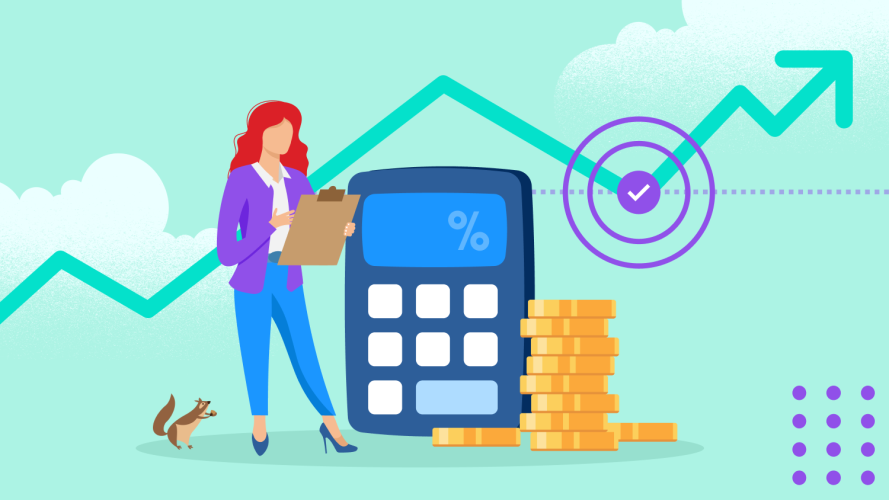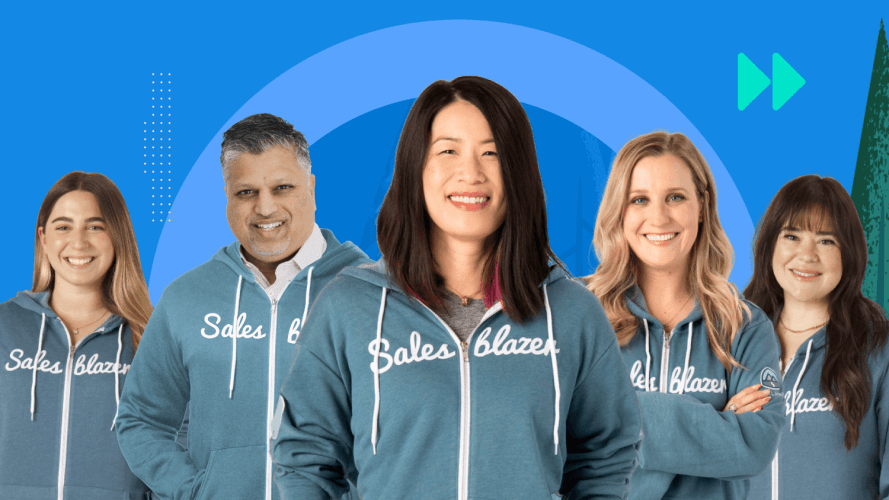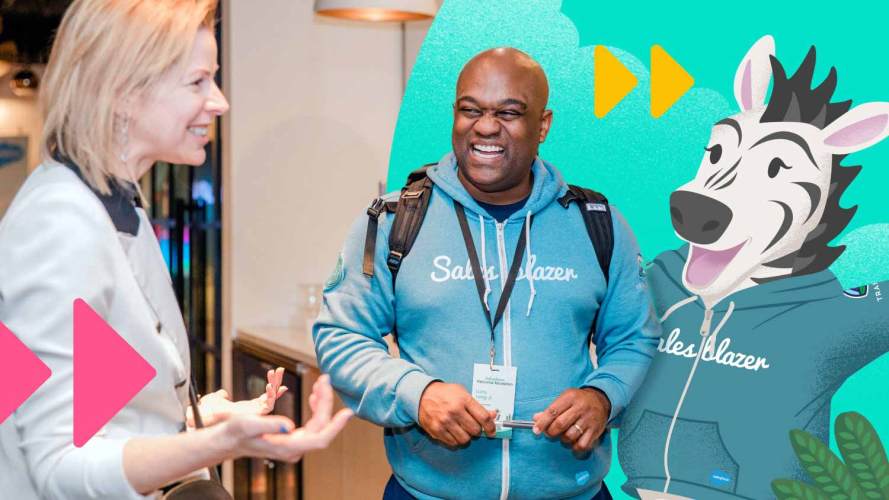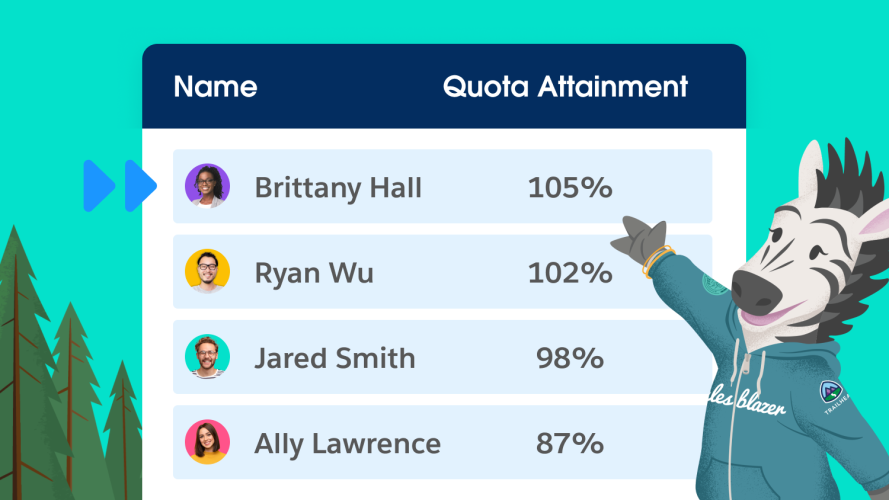Learn Which High-Gain Questions to Ask So You Can Close Faster



Move your deals forward by asking the right questions at the right time.

Molly Clarke
All reps enter sales conversations with the same goals. They want to learn about the prospect, tailor the pitch to their needs, and put them on a path toward closing a deal. So why do some reps consistently succeed while others fail?
Ultimately, a rep’s success during sales conversations hinges on the questions they ask – not just what they ask for, but how they ask for it.
In order to consistently secure the information you need to convert prospects into customers, you need to make sure you’re asking high-gain questions. This article gives you everything you need to know.
What you’ll learn:
- What are high-gain questions?
- High-gain questions vs. dead-end questions
- 8 types of high-gain questions to close more deals
Drive pipe faster with a single source of truth
Discover how Sales Cloud uses data and AI to help you manage your pipeline, build relationships, and close deals fast.



What are high-gain questions?
As the name suggests, a high-gain question is one that seeks to gain the most valuable information from a prospect as efficiently as possible. High-gain questions are thought-provoking, getting the prospect to think deeply about their business, pain points, purchasing decisions, and potential solutions.
While this sounds a lot like an open-ended question, there’s a key distinction – efficiency.
Open-ended questions are effective because they keep the conversation moving and create a smooth dialogue rather than a stilted back-and-forth. But simply asking open-ended questions isn’t enough. A pleasant two-way dialogue can be a meandering time-waster if the open-ended questions used to spark that dialogue lack purpose and direction.
High-gain questions are a sales rep’s best friend because they’re open-ended in nature, but strategically timed and structured so that the prospect provides the most valuable information in the shortest amount of time.
High-gain questions vs. dead-end questions
A high-gain question should never result in a “yes” or “no” answer, as its purpose is to get the prospect to explain or elaborate on specific details that are relevant to an eventual purchase decision. Dead-end questions do the opposite: They typically elicit “yes” or “no” answers, or answers that are simple, declarative, and don’t naturally move the conversation forward.
Dead-end questions usually start with words like “Do,” “Does,” “Are,” or “Is.” For example: “Does this fall into your budget range?” or “Is this tool something your team is looking for?”
These types of questions aren’t without value; particularly at the end of a sales conversation, it’s important to ask a few brief, straightforward questions to confirm important details, address lingering concerns, and make sure both parties are aligned on next steps.
But when asked at the wrong time, dead-end questions can stifle the conversation before it really gets going – or worse, make the prospect feel like the sales rep is being too pushy, manipulating them, or rushing the conversation to secure a sale as fast as possible.
There’s a proper time for all types of sales questions, even dead-end questions. But a sales conversation can only succeed if the sales rep is asking the right high-gain questions at the right time.
8 types of high-gain questions to close more deals
There are many types of high-gain questions. Each of these captures information that a sales rep needs to understand the prospect, pitch their product, and close a deal as efficiently as possible.
1. Decision-maker magnets
Many sales conversations suffer stops and starts because the sales rep is either speaking to the wrong person or hasn’t included all of the essential stakeholders in the conversation. Decision-maker magnets are questions that help you locate the right contacts and get them on the phone:
- “Can you describe your role at your company?”
- “Who is responsible for [X business function that the solution addresses]?”
- “I’m looking to speak with someone at your company about a solution that can help you achieve [X result]. Is this something you’re prepared to discuss with me today?”
- “Is there anyone else you think I should speak with about this?”
- “If we do happen to move forward, who is ultimately responsible for approving this kind of purchasing decision?”
The number of decision-maker magnets you ask will depend on who you’re speaking to and how you get in contact with them. If you quickly confirm that you’re talking to a primary decision-maker who wants to learn about your product, great! You can move the conversation forward. If there are additional stakeholders you’ll need to speak with, talk through a plan to get them on the phone.
2. Door-openers
Door-opening questions are typically used by reps during cold calls to demonstrate interest and quickly identify ways to keep a prospect engaged in the conversation – even when the outreach was unprompted.
People often bristle at the idea of accepting a cold call and, for this reason, it can be difficult to get cold calling right. But the right high-gain questions can get you in the door and in front of an engaged audience faster.
- “I know [job titles] I speak to often struggle with [X process]. What does this look like in the [blank] industry?”
- “What do you look for in a [specific type of product you’re selling]?”
- “How are you holding up, given the [X seasonal or timely problem]?” (Examples: end-of-year planning, holiday rush, tax season, etc.)
- “What would need to happen for you to look into a new [specific type of product you’re selling]?”
- “What would it cost you if your company were to continue doing things the exact same way for another year?”
- “How does your company think about [specific topic or problem]?”
- “What’s your biggest priority at the moment?”
The goal of a cold call is to both qualify and understand the needs of the person you’re speaking with. You want to make sure you speak to the right person and that their needs are aligned with your solution. High-gain questions give you a way to gather information in potentially uncomfortable situations. Instead of a cold pitch, high-gain questions allow for a conversation.
3. Pain point identifiers
Uncovering the prospect’s pain points is one of the most crucial steps in any sales conversation. When you know the problems that are hindering a prospect’s success – and the consequences of leaving those problems unsolved – you gain an advantage over competitors who don’t.
Ask these high-gain questions so you can steer the rest of the conversation in the right direction, focusing on the prospect’s specific needs and omitting irrelevant details:
- “What led you to take this call today?”
- “What are your most important priorities in your role at your company?”
- “What’s the biggest problem that has stopped or hindered you from fulfilling these priorities?”
- “How long have you been dealing with this problem?”
- “What are the day-to-day consequences this problem has caused? Can you give me some examples of what you’ve had to deal with?”
- “Who else is impacted by this problem?”
- “Outside of its impact on the business, how much of an impact has this problem had on you personally? What has bothered you the most about this issue?”
- “When I talk to other companies, one of the most common problems I hear about is [X problem]. Is this an issue for you as well?”
- “What other problems are you experiencing? Are these secondary problems a result of your main problem, or separate issues?”
Beyond gathering information, these paint point identifiers also help to establish a rapport and build trust. Discuss pain points on a personal level and you’ll have an easier time getting transparent answers to all your future questions.
4. Timeline questions
Establishing a timeline is an essential part of any successful deal, which is why most mutual action plans focus heavily on timeline creation and expectation-setting. When speaking with a prospect, ask the following high-gain questions to arrive at a mutually agreed-upon timeline more efficiently:
- “We just discussed [X pain point]. How urgently do you need to solve this problem?”
- “When do you hope to have a solution in place?”
- “When making purchases of this size and scope in the past, how long did the deal take to finalize?”
- “Barring any roadblocks, how long do you anticipate it will take to make a decision on this deal?”
- “What would we need to do to ensure we meet a timeline of [X]?”
- “In order to start [specific project] we’ll need [specific deliverables]. What do you need from me to make sure you’re able to hit those deadlines and keep this initiative on track?”
If the prospect struggles to provide you with a firm timeline, provide them with a suggested timeline based on past deals so that you can arrive at a rough estimate. And if their proposed timeline doesn’t align with yours, brainstorm steps you could take together in order to meet somewhere in the middle.
5. Competitive assessment
It’s important to understand whether your solution is the only one the prospect is considering, or if they’ve already researched, contacted, or met with any of your competitors. The last thing you want is to get close to closing a deal only to have the rug pulled out from under you when the prospect chooses a competitor you weren’t even aware they were talking to.
Knowing who you’re up against will help you tailor conversations to give yourself a competitive advantage. If the prospect is looking at another provider, you might emphasize the benefits and capabilities your solution offers that the competitor does not. Here’s a closer look at possible questions:
- “How have you attempted to solve this issue in the past?”
- “Which other products and services have you tried or considered trying?”
- “What is your biggest concern when it comes to my solution?”
- “If you’ve evaluated other vendors or services, what is it you liked most about their platforms?”
- “If you’ve evaluated other vendors or services, what is it you disliked most about their platforms?”
- “What would a product or solution have to offer to win your business?”
- “What criteria are you using to evaluate [specific type of product]?”
- “How does my product stack up to the others you’re evaluating?”
When asking these questions, make sure to use a calm tone and refrain from pushing too hard on details the prospect seems unwilling to share. Your goal is to assess your competition without sounding defensive, dismissive, or judgmental.
6. Objection predictors
Countless sales reps have finished a conversation with a prospect and believed a deal was a foregone conclusion – only for unexpected roadblocks to pop up later and stall the deal or ruin it entirely.
Ask the following questions once you’ve built a rapport with the prospect and outlined most of the key steps of the deal. That way, the prospect will understand enough to be able to look ahead and consider what realistic hurdles might appear following this conversation.
- “Based on what we’ve discussed, can you think of any potential roadblocks that might come up?”
- “Knowing the other stakeholders, do you foresee any objections or concerns they might have about this solution?”
- “When you’ve been a part of similar deals in the past, have you run into any problems that we can hopefully avoid here?”
- “Imagine the worst-case scenario. What’s the one thing that would have to happen in order for the deal to fall apart?”
- “When we first talked, your main priority was [specific initiative]. Is that still the case?”
- “You were originally hoping to have launched [specific initiative] by [specific date]. Is this still a main priority for you?”
- “Is there anything you need from me to make internal discussions about my product easier?”
- “Have I done a good job showing you how [specific product] solves [specific problem]? Is there something else you’d like to see or discuss?”
Of course, asking these questions doesn’t entirely remove the risk of an objection appearing down the road. But, by allowing the prospect to stop and consider all possible scenarios, you’ll likely uncover some potential objections and strategize ways to avoid them.
Join the Salesblazer movement
We’re building the largest and most successful community of sales professionals, so you can learn, connect, and grow.

7. Sentiment gaugers
During any sales conversation, remember to stop and gauge the prospect’s feelings about your solution – not just once or twice, but repeatedly throughout the conversation.
Feelings can change quickly, and a prospect who was excited about your solution might be apprehensive or skeptical minutes later. Think of these questions as checkpoints to spread throughout the conversation so you always know how the prospect is reacting.
- “How are you feeling about this conversation so far?”
- “How are you feeling about the product now vs. how you felt when you first picked up the phone?”
- “We covered a lot of ground just now. Is there anything I went over too fast that you’d like me to touch on again?”
- “What’s exciting you most about the product?”
- “Have I said anything that’s raised any concerns?”
- “Before we move on, the floor is yours – any questions nagging at you that you’d like me to answer?”
Return to these high-gain questions after you’ve just gone over consequential information related to your product’s capabilities, the pain points it can solve, timelines, and money. During complex buying cycles, a single detail can sway the prospect’s emotions. You want to recognize the change soon after it occurs so you can capitalize on positive sentiments and alleviate negative ones.
8. Money/budget questions
You can’t truly know if a prospect is qualified until you know whether or not they can afford your product and are willing to spend your asking price. And every sales rep fears the moment their manager asks them about a prospect’s budget and they have to respond with: “I don’t know,” “They’re not sure,” or “They wouldn’t tell me.”
Asking about budget can be extraordinarily easy or frustratingly difficult depending on the prospect in question. The following list of high-gain questions covers different methods for asking about budget, depending on the prospect’s transparency and comfort level with sharing these details.
- “What budget do you have allocated for this solution?”
- “To solve [X], how much are you willing to spend?”
- “How much does your company typically budget for solutions like this?”
- “Has budget been an issue when you’ve looked at solving these problems in the past?”
- “A customer who is comparable to your company spends somewhere around [X] per month on [X solution]. Does that align with what you’re looking to spend?”
- “How flexible is the budget range you’ve provided?”
- “What requirements would a tool or service have to meet in order for your company to spend money on it?”
- “How did your team decide on your budget for this project?”
- “What would the financial impact be on your company if you were to continue doing [task] the way you’re doing it now?”
- “Now that you understand what [specific product] does, what would your ideal price range be?”
- “I know you’re incredibly busy. In order to make sure we’re aligned on pricing and budget, and to save us both the time, when do you think it makes sense to discuss pricing?
- “Is there anything I can do to help you understand or justify spending money on our product?”
There’s also that all-important question: When should you bring up budget? Despite what many will tell you, there’s no one-size-fits-all answer to that question.
If a prospect is very transparent, seems eager to move forward with you, and responds favorably to the information you provide, it’s acceptable and even beneficial to mention budgets earlier on in the conversation – as they’re likely waiting for you to do.
The benefit of having pricing conversations earlier in the sales cycle is that it allows you to save time disqualifying organizations that may never have the resources to pay for your product.
But, if your prospect seems guarded, skeptical, or on the fence about purchasing, mentioning budget too soon might scare them off before they’re even sure how they feel about your solution.
Here’s a good rule of thumb: Make sure the prospect understands the value your solution will provide before they have to consider what they’ll pay for it.
If you fail to communicate value, your prospects won’t be willing to spend money on your product or service. Conversely, if they understand the problems you solve and how it impacts them, they’ll view you more as a partner and the purchase as a mutually beneficial deal – and talking budget will get a whole lot easier.
Master the art of high-gain questions to make sales conversations more impactful
Every sales conversation isn’t going to go as smoothly as you want it to. The unpredictability of sales is precisely why it’s so important to perfect the details that are in your control. Mastering the art of asking high-gain questions is a surefire way to have more valuable sales conversations, gather the right information faster, and excite the prospect about your offering.
8 sales productivity pitfalls (and how to avoid them)
Get the Sales Productivity Workbook and avoid pitfalls like bloated tech stacks and approval bottlenecks.


























